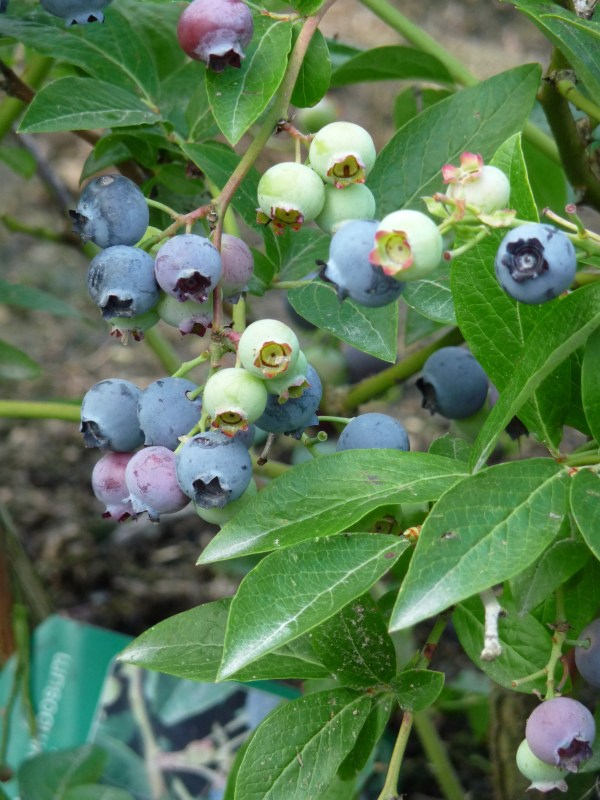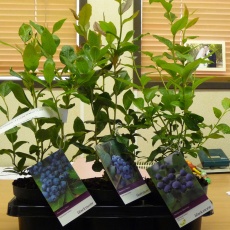Blueberry Duke
Bulk discounts available:
2+ 3 Litre @ £14.28 each
Home Delivery
UK mainland delivery from £5.50
Check delivery cost
Loyalty Scheme
Earn up to 14 loyalty points with this product.
Finance Available
This item is available on finance.
Product Description
Blueberry Duke Growing Tips.
Care Guide For Duke Blueberries: If you have purchased your Blueberry plant during its winter dormant season, then there is no need to do anything except plant it, until the plant emerges from the winter. Blueberries must be grown in moist, acid soils with a PH of between 4-5. If you can grow Rhododendrons and Azaleas in your soil without any sign of yellow leaves then you can grow Blueberries in the ground but if this is not the case then you will need to grow them in containers with ericaceous compost.
You will notice that the buds swell as spring draws nearer. The large, fat buds near the tips of the shoots are your flowers and fruit this season and the smaller ones are shoots and leaves. As temperatures rise, these buds burst open and growth starts.
Spring: When the leaves have emerged fully, usually towards the end of April, your plant will need its first feed. A balanced ericaceous fertiliser (rhododendron/azalea fertiliser) is recommended. (IMPORTANT NOTE: Fertilisers used for tomatoes and vegetables are generally not suitable as they do not contain the correct balance of nutrients. Any form of animal manure is also unsuitable for Blueberries).
Summer: Repeat feeding the plant at the end of June because Blueberries have a second stage of growth in late summer. The whole of your plants root system should be kept moist throughout the growing season, preferably using rainwater as this tends to be acidic. As the fruit starts to colour, try to cover the plants with bird netting to avoid theft of your precious berries. Soft water from the mains can be used if rainwater is not available but hard water is not suitable. In mid to late summer, long canes will grow up through the bush. This is the framework for the future. Pinching out the tips of this growth will encourage a bushy plant, as done for fuchsias and chrysanthemums.
Autumn: This is the time for tidying up and mulching. Do not carry out deep cultivation too close to your plant in order to avoid damaging shallow roots. The addition of well-rotted woodchip mulch to the surface around your bushes will conserve moisture and help to control weeds. Winter: Pruning is carried out after leaf fall, in mid winter while the plants are dormant. For the first two years after planting, your bushes will need very little pruning, except general tidying up and shortening of very long shoots to encourage branching. Many growers remove all or most of the flower buds in the first year. This will encourage vegetative growth instead of fruit production, thus making a more substantial plant for the following year.
The philosophy of pruning is: To stimulate new growth and keep the plant yielding large crops of big berries
To remove unproductive, diseased, dead or dying wood.
To remove branches which are too high or too low.
To thin out overcrowded branches Blueberries fruit on short lateral branches grown during the spring or early summer of the previous year. The strong branches that grow in late summer may produce fruit buds at their tips. If desired the branches can be cut back by half in winter to encourage branching, although this is at the expense of their fruiting tips.
First, remove any whippy green narrow growth from the base. This will never produce anything and is worthless. All wood that has borne fruit the previous year can then be taken back to the next strong, young growth. When this is complete, stand back, look at your bush and start detail pruning and tipping branches that have died back. This will help to reduce fungal infection in future years. The rule is "If in doubt, take it out". At the end of pruning mature bushes you should probably have removed up to 1/6 of the bush. It is very important to remove the prunings from your garden, either by burning or taking to your local refuse site.
This guide is for general information purposes only as site and soil conditions and requirements vary greatly.
This tab appears on all products! Making it easy to update content across the site with one simple change in the CMS site settings
Simply remove the text from the site settings and this will remove the tab from all products.
Text:
Tab Content goes here
- bullet
- italic bullet
- bold bullet
Image:







Share and compare...
wish list compareShare
Blueberry Duke
Facebook Twitter Email Pinterest Telegram